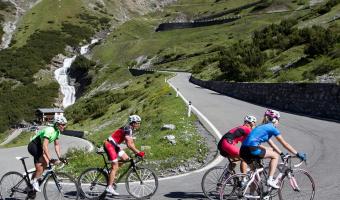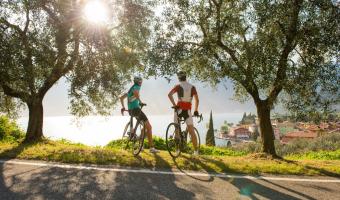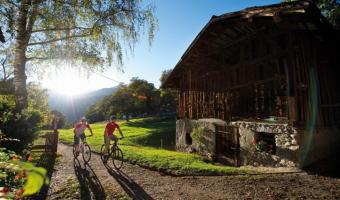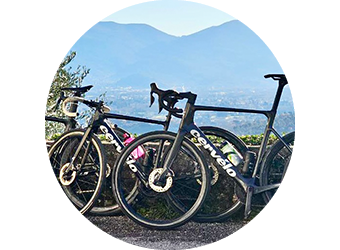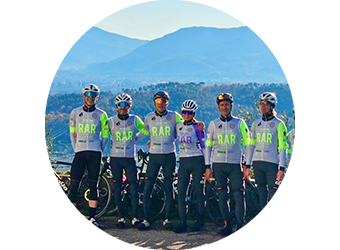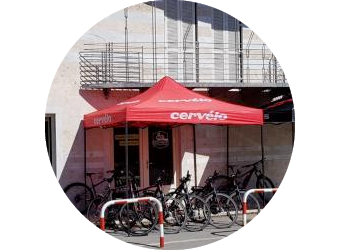Lucca
One of the most beauty art city of Italy, Lucca is a monumental and historical culturale heritage site. It is surrounded from his sixteenth walls. Because of their architectural structure, it is possible to walk or ride it by bike. The downtown is typical of medieval age, there are a lot of historical churches that characterize the old splendor of the city in a contemporary atmosphere because of today events and representations.
Lucca walls
They are the second major example in Europe of walls built with the criteria of modern fortification. They always are integrals. Lucca’s walls are 4,223 kilometers long. It depends on the last reconstruction started in 1504 and finished more than a century later, in 1648. They had never been used as a defensive barrier, today you can see 12 curtains and 11 bastions. These are saw as an identity cultural signe and as a container for historical place memories. The walls where built as a deterrent in particular for the Republic of Lucca which was afraid of Florence and Grand duchy of Tuscany.
Anyway, it had never been a real war but it was just a war between Lucca and Grand duchy of Tuscany. The walls were converted in a walk itinerary by Maria Luisa di Borbone-Spain(from 1815 till 1824) in order to make walls become a public garden. What mada it possible was the 4 kilometers length. The new employement of the walls was important for external areas, too. Infact, they was turned into big fields. The upper walls walking it is actually used to walk and to make some jogging, but in well weather seasons is a suggestive scenary for events.
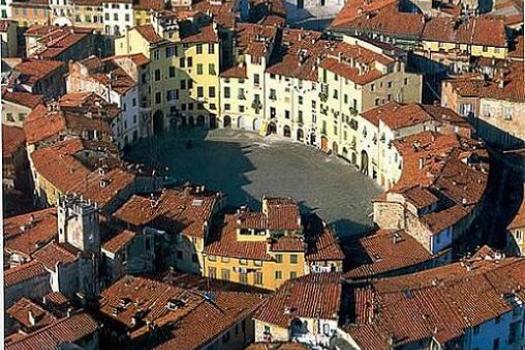
Amphitheater Square. Lucca
It is a square situated in Lucca downtown. It was built upper the rest of an ancient Roman Amphitheater.(II century A.C.) whose determinate his plant. The square was built during the middleage and it was called Parlascio from the latin name of Paralisium( amphitheater). It was an area where people talked. It was implemented with other buildings, utilized as salt and war gun deposit and as cellars. In Eighteenth a revaluation plan was ordered by Lorenzo Nottolini, an architect from Lucca. The area around the arena was clean up and Amphitheater street was opened. Today this square is about three meters upper than romanic arena. The access to the square is possible by 4 ways, but just only one preserve the original aspect. You can find there a lot of shops.
The Church of San Michele. Lucca
It’s a religious area of Lucca situated in San Michele Square. During the eight century, In the center of the ancient forum of Lucca, a church was built. It was San Michele’s Church. Other buildings where linked to this church, respectively: a hospital and a monastery. Its restructuration started in 1070 under the supervision of Papa Alessandro II and they stopped in XIV century. San Michele is a latin church influenced by Romanic and Pisan style. The façade has 4 lodges surmounted by a big marble statue of Arcangelo Michele with his metal wings. He is trying to kill a dragon. You can see two angels, too. During some days, as a tale says, it is possible to see a brilliant emerald inside the statue who reflect green light.
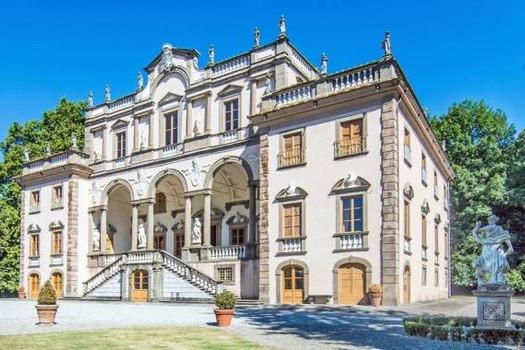
Mansi Villa . Lucca
Is one of the most famous Villa in Lucca. The Villa is presented by a façade in mannierism style. In front of the villa there is a beautiful field. The rooms are in Baroque style. All the ornamental elements are golden. Lucida Samminiati or well known as Lucida Mansi was Gaspare Mansi wife. It is told that she died for Peste in 1649. A lot of histories about her are told. For example it is told that she made a patto with the devil, which he had been gave her thirty years of youth. nAt the end of this period, the devil took her and by a fired couch she was brought to Orto Botanico lake where she was tossed.
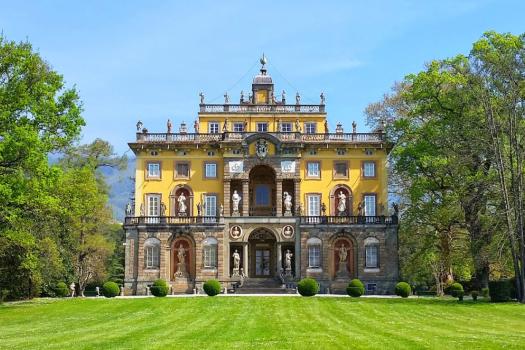
Torrigiani Villa. Lucca
This villa is different from the other for the policromie of the facade obtained with different materials: green rocks and yellow tuff alterned in pillars and arches. White marble for statues and ocher plaster in the lower building and white for the highest part. Windows are originals elements that distinguish this Villa from the others. Alfonso Torregiani was the architect of Villa Torregiani. The background façade is old middleage style and is characterized by a big Tuscany colonnade. Inside there are some stairs and other typical and stranges decorative items. In the mansard there is a private theatre.
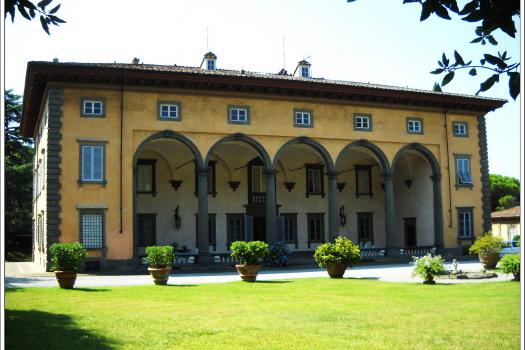
Buonvisi Oliva Villa . Lucca
Villa Oliva is situated in San pancrazio, near Lucca. Although this villa is private, it is possible to visit it. The first news about thi villa are coming from 500 whe the owners where Buonvisi. After the Villa was obtained by Montecatini, Carlo Poniatowski and Rosselmini, whose they donored this villa to Piccola casa della Divina Provvidenza of Giuseppe Benedetto Cottolengo. During the second world war, the villa and his garden were damaged. A lot of mosaics and pillars were distructed. The big operas of rebuilding were made from Cesare Oliva and his wife Luisa, actual owner.
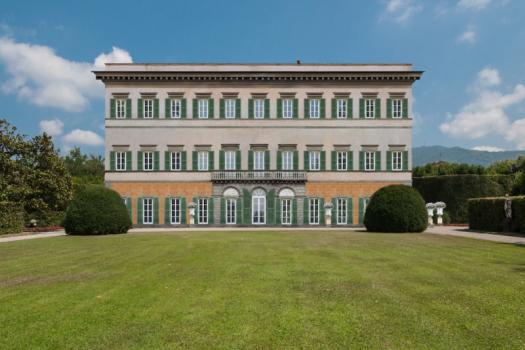
Reale Villa. Lucca
Surrounded by high walls that seem to protect it by time passing, Lucca, in the heart of Tuscany, in a privileged location at the foot of the plateau Pizzorne. Considered one of the most important historical houses in Italy, in the 19th century it was the residence of Elisa Bonaparte, Napoleon's sister and Princess of Lucca. The property covers an area of 16 hectares and includes numerous and refined gardens, botanical rarities and imposing palaces built over the centuries. The Park is crossed by avenues of Camellias and is home to two famous theatres, that of water and Greenery (where she performed often on famous violinist Paganini for Elisa Baciocchi); to embellish you add the lemon garden, with the marble group of Leda and the Swan, and the Spanish garden Deco taste.
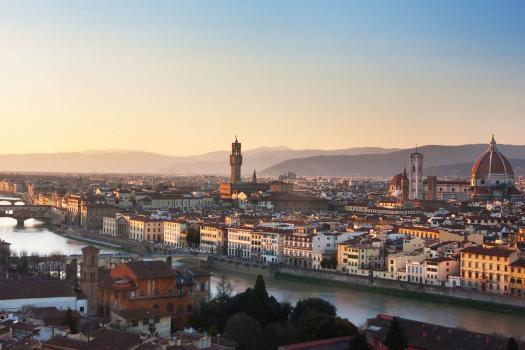
Florence, the cradle of Renaissance
Florence, important cultural, commercial and financial centre in the middle ages, the capital of the Grand Duchy of Tuscany for three centuries and capital of Italy after the unification of the country in 1861, is now the provincial capital of Tuscany. Unesco World Heritage site since 1982, is one of the most beautiful cities in the world, thanks mainly to its numerous monuments and museums including the Duomo, Santa Croce, the Uffizi Gallery, Ponte Vecchio, played even in Las Vegas, unique in the world for jewelers in houses built on it. Piazza della Signoria, Florence and the Pitti Palace with its eight museums.
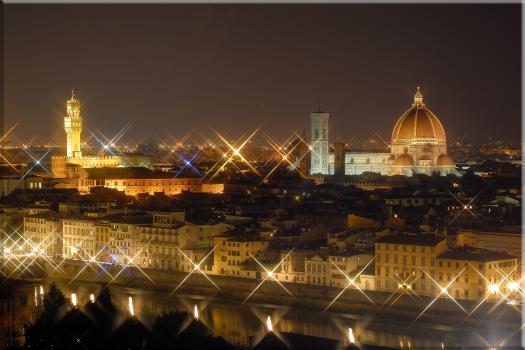
What characterizes Florence is the uniqueness of his position, in fact forms part of a hollow Amphitheater across the Arno rivers below. Though it has always been inhabited since prehistoric times, is remembered for its Renaissance splendour, characterized by the development of scientific, literary and artistic, just think of Leonardo da Vinci, who created some of his masterpieces like the Mona Lisa. Florence is universally recognized as a city of art because its architecture, sculptures, scientific and historical memories form the urban fabric.
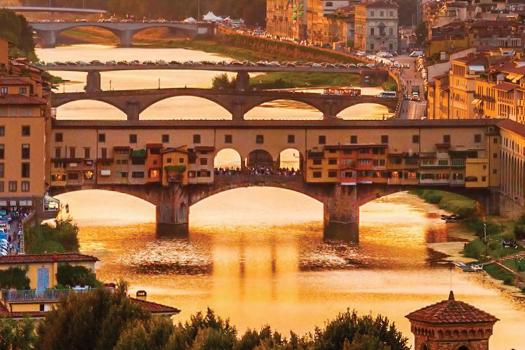
The Ancient Bridge. Firenze
It is one of the symbols of the city of Florence and one of the most famous bridges in the world. Crosses the Arno River at its narrowest point, where in ancient times there was a Ford. The Ponte Vecchio is composed of three large segmental arch passes (height/width ratio 1:6); for the first time in the West was being outweighed the Roman model which provided for the exclusive use of semicircular crossings (i.e. semicircular arches) that in the case of a very long bridge required a large number of arcades, thus creating potential hazards in the event of full (for easy narrow crossings obstruction) or a slope very pronounced, solution equally undesirable. Another typical characteristic, far more apparent to tourists but less revolutionary, is flanked by two rows of craft shops, housed in old arcades then closed, which made him famous, as if it were the continuation of the road. The shops of Ponte Vecchio all overlook the Central passageway, each with a single window closed by thick wooden doors, and often have a back room cantilevered over the river built and supported by Corbels (or "made").
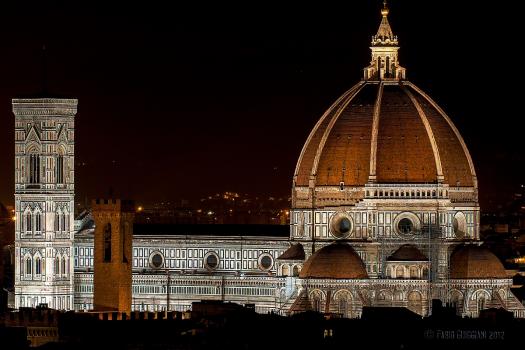
The metropolitan Cathedral of Santa Maria del Fiore (Duomo di Firenze ). Firenze
It is the main Florentine Church, symbol of the city and one of the most famous in Italy and the third largest church in the world. The construction of the Cathedral, ordered by the Florentine Signoria, began in 1296 and structurally ends only in 1436. Initial work was entrusted to the architect Arnolfo di Cambio before being interrupted and resumed several times over the decades (by Giotto, Francesco Talenti and Giovanni di Lapo Ghini). Upon completion of Brunelleschi's dome followed the consecration by Pope Eugene IV on March 24 of 1436. The dedication to Santa Maria del Fiore occurred during construction, in 1412.La plant of the Cathedral is composed of a three-aisled basilica with a huge round triconica welded supporting the immense dome by Brunelleschi, the largest masonry dome ever built. Inside you can see the largest surface ever decorated with frescoes: 3600 m ², produced between 1572-1579 by Giorgio Vasari and Federico Zuccari.

The Ancient Palace
is located in piazza della Signoria in Florence and is the seat of the municipality of the city. Is the best summary of the fourteenth-century civil architecture in town and one of the best known civic buildings in the world. Originally called "Palazzo dei Priori, became in the 15th century" Palazzo della Signoria ", named after the main body of the Florentine Republic; in 1540 he became Doge, when Duke Cosimo I de Medici made it his residence; Finally the name old hired him after 1590 when the Court of Duke Cosimo moved to the "new" From 1865 to 1871 was Pitti Palace. the Parliament of the Kingdom of Italy and today houses the Mayor of Florence and various municipal offices. There is also a Museum, which allows you to visit the magnificent rooms where paintings by Michelangelo, Donatello, Verrocchio.
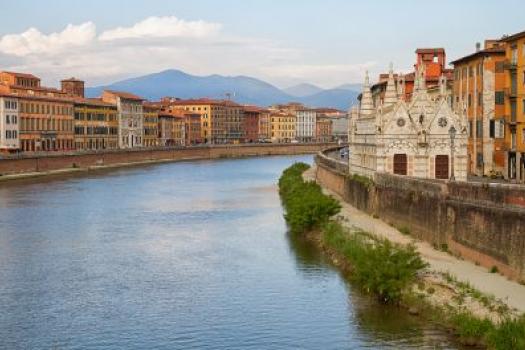
Pisa
The city legend was founded by some mythical Trojan refugees coming from the Greek city of Pisa, post a time in the Valley of the river Alpheus, in Peloponnesus. Among the most important monuments of the city there is the famous Piazza del Duomo, known as Piazza dei Miracoli, declared world heritage, with its Cathedral built between 1063 and 1118 Pisan Romanesque and the leaning tower , 12th century Bell Tower, now one of the world's most famous Italian monuments due to its characteristic inclination. The city is home to three of the most important universities of Italy and Europe, the University of Pisa, Scuola Normale Superiore and the S'anna high school, as well as several research studies.
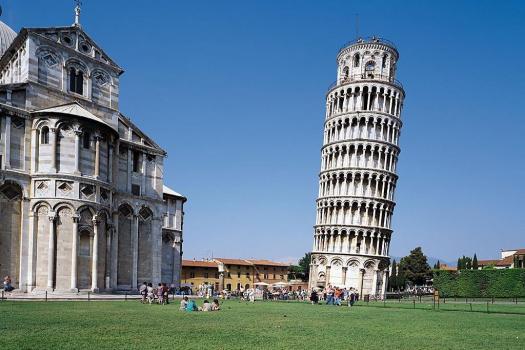
The leaning Tower. Pisa
placed on a clay soil and sandy soil, it seems he began to tilt since the building of the third floor so much that she had to suspend work for then take them back years later, building subsequent plans with a curvature in the opposite slope. The original design is thought to have been by Diotisalvi, that during the same period was building the Battistero.La construction continued until completion in 1350, reaching a height of 56 metres and a weight of 14,523 tons, managing to keep it in balance because the vertical passing through the Centre of gravity falls within the base. Total 8 floors, surrounded by a loggia with round arches, which reflect the pattern of the façade of the Cathedral and the belfry Tower is, as were placed 7 bells.
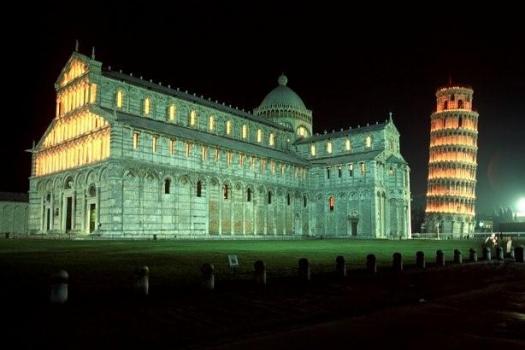
The Miracle's square. Pisa
The square begins to take shape in 1064 when the core of the complex: the Cathedral of Santa Maria Assunta. Represents the ultimate expression of the Romanesque pisanico influenced at the same time from different stylistic elements. At that time Pisa was a maritime Republic (XI-XV), the sailors were traveling in the Arab world remained struck by its beauty. A few years later began expanding the walls (the Church initially there was included) and construction of the baptistery (1152): was placed in front of the Cathedral with diameter equal to the façade of the latter. About 20 years later you will also work on the bell tower which is the "leaning tower" and in 1277 to the Campo Santo.
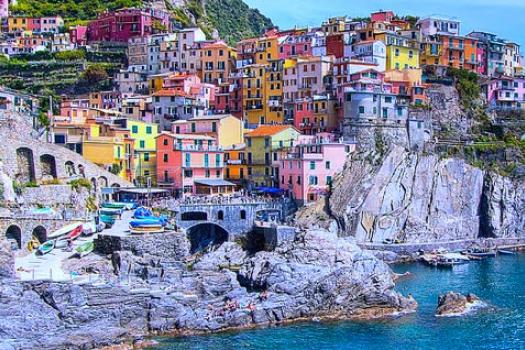
Le Cinque Terre
5 Terre is a Jagged coastline of the Italian riviera in the province of La Spezia between Punta Mesco and Punta Montenero, in which there are five villages or, as it was called in ancient times, Earth, listed here from West to East: Monterosso al mare, Vernazza, corniglia, Manarola, Riomaggiore. In 1997, at the request of the province of La Spezia, Cinque Terre, together with Portovenere and the Islands Palmaria, Tino and Tinetto, were included in the world heritage of humanity by UNESCO.
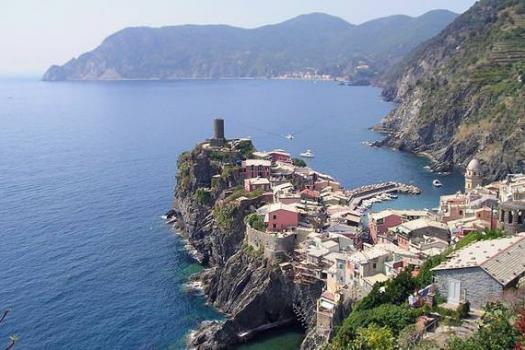
Thanks to its geographical and human factors of the territory where, the Cinque Terre are considered one of the most beautiful Italian coastal attractions, for their rough and bumpy, hilly terrain context naturally sweetened by the construction of terraces or bands for cultivation, sinking into the sea with steep slopes; where the sea creeps as a sneak in the Earth are the villages, articulated to follow the natural shape of the hills.
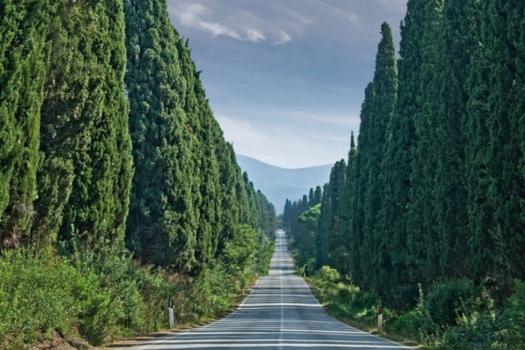
Bolgheri
At the heart of the Maremma Livornese, we find Bolgheri, a picturesque medieval village perched on a small hill can be reached through a long and impressive Cypress worthy to be depicted on a postcard. Bolgheri is famous not only for its beautiful scenery and architecture, even for red wines that are produced in the area. Among the most famous find Sassicaia by Tenuta San Guido, the Tuscan wine world's most popular. Most of the wines produced in Bolgheri report DOC.
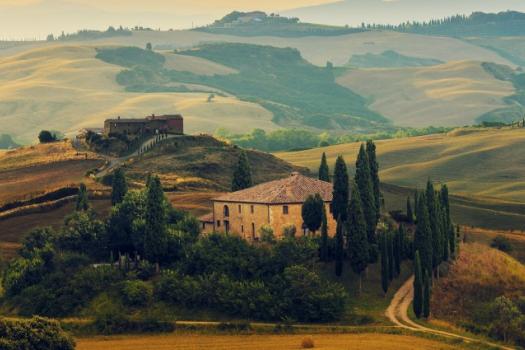
The village grew around the medieval castle (extensively remodelled over the centuries) that sits on a small hill to reach through the impressive Cypress Avenue, long road almost five kilometers downstream, on the via Aurelia begins, just before the eighteenth-century oratory of San Guido: the place has been made famous by the verses of Giosue ' Carducci in poetry in front of San Guido (1874). Not far from the settlement, on high ground mail to almost 400 meters above sea level, lies the ancient fortified settlement of Castiglioncello di Bolgheri, with the Church of San Bernardo.
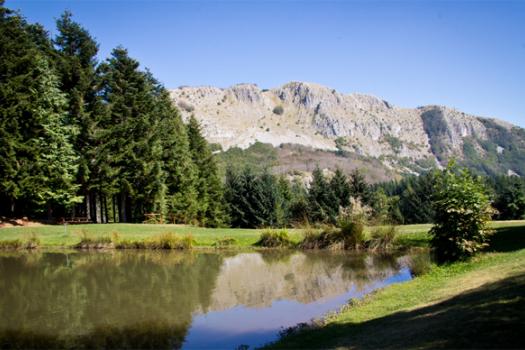
La Garfagnana
(low Latin Carfaniana) is a historical and geographical region of the province of Lucca, between the Alps and the main chain of the Apennines. Bordered on the North by the Lunigiana, to the West by the Versilia and Massa, on the East by the Emilia Romagna region (provinces of Modena and Reggio Emilia), and on the South by the Mediavalle of the Serchio is entirely crossed by the river Serchio and its many tributaries and is rich in woods. Its altitude varies between 132 and 2054 m s.l.m.La Garfagnana offers a wide variety of landscapes, from a rugged and Rocky Mountain zone untouched, the Apuan Alps and the grassy slope sweeter in the Apennines, which becomes smaller quotas in a hill full of meadows and cultivate a particular scenic beauty. The river Serchio river bed with a large stony (in Garfagnana "la Jara") marks all over the center of the slope of the Valley.
The fortress of Verrucole. Garfagnana
is a fortress located in San Romano in Garfagnana near Lucca, in Tuscany, of which the first records date back to the middle ages. A first settlement-defensive, which no longer exists, was built by the counts Gherardinghi who dwelt until 1285, when it was sold to the Republic of Lucca. The current renaissance fortress, for about 400 years, was impregnable military garrison of the Dukes d'Este of Ferrara-Modena and today, after a major restoration by the city of San Romano in Garfagnana is open thanks to a project of historical reenactment.
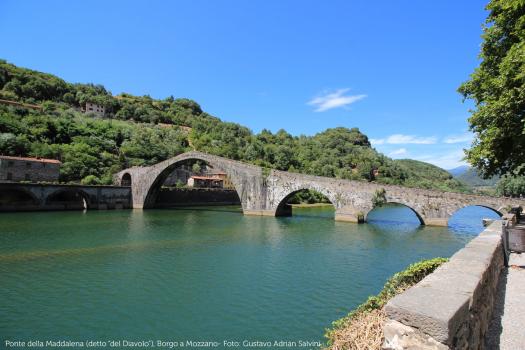
Maddalena’s Bridge. Garfagnana
It is commonly identified as "Devil's bridge". Like many other companies to coeval seemed impossible, the popular legend attributes the construction to the devil, who is then conned in various ways. Legend has it that engaged in the construction of the bridge builder Cape was very concerned about the delays in the same building. He then came to terms with the devil, which allowed him to finish the job in one night in Exchange for the first soul that had crossed the bridge. But the legend continues ...


